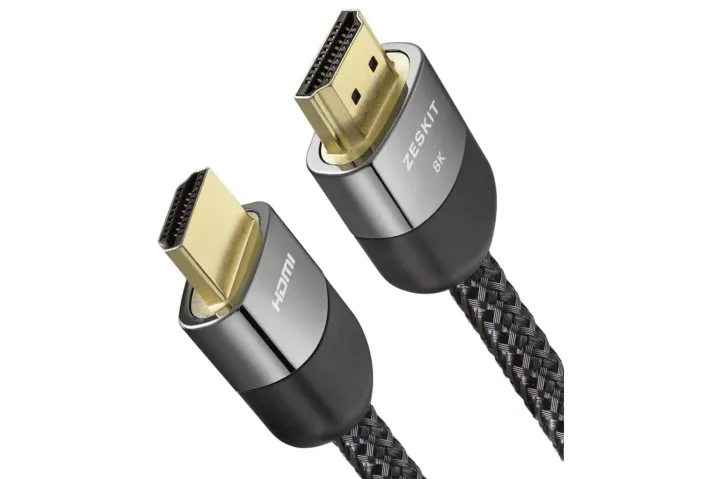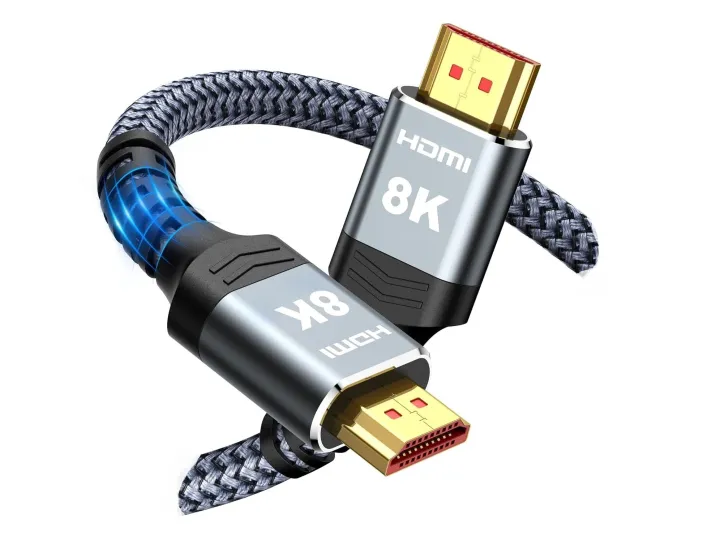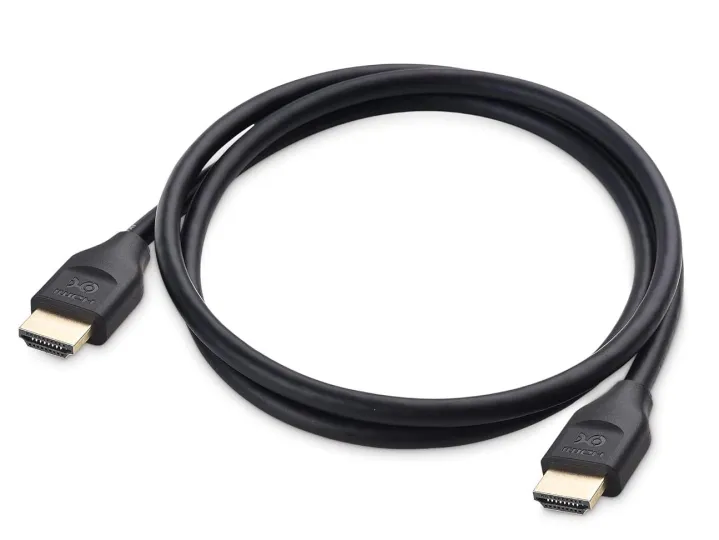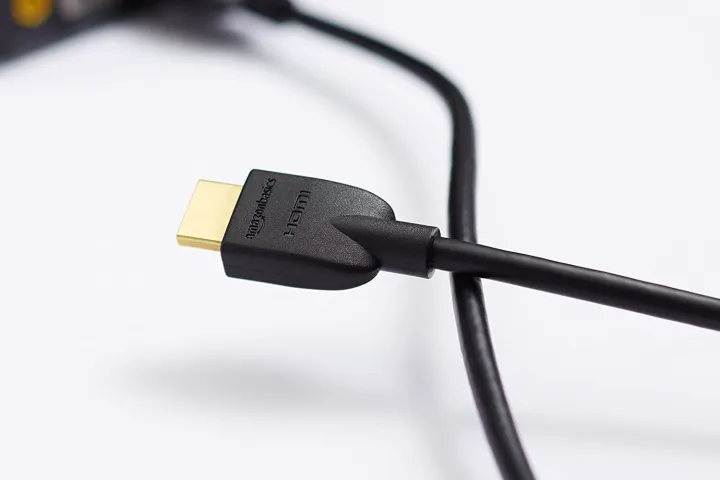When you need to buy an HDMI cable, you may face two common problems. The first is not paying enough attention, or grabbing the first cable that says HDMI from a random store. This can lead to wasting money on a low-quality cable, and not getting the best HDMI cable for your needs.
The second problem is the opposite: paying too much attention. You may spend hours researching HDMI cable brands, lengths, versions, prices, and so on. But the truth is, the best HDMI cables are not the ones that keep you awake at night. HDMI cables, when they work well, are hardly noticed in most situations. You just plug them in and let them do their job. This guide will help you avoid overthinking, and make your HDMI cable choice easy and simple.
Our Top Picks
| Image | Product | Feature | Price |
|---|---|---|---|
|
Best Overall

|
Zeskit Maya Ultra HDMI Cable
|
|
Check Price |
|
Best Selling

|
Highwings 8K HDMI cable
|
|
Check Price |
|
Best for Pc Gaming

|
Cable Matters 8K HDMI Cable
|
|
Check Price |
|
Best Budget

|
Amazon Basics HDMI 2.0 Cable
|
|
Check Price |
1. Zeskit Maya Ultra HDMI Cable
If you are looking for a high-quality HDMI cable that won’t break the bank, you might want to check out the Zeskit Maya HDMI 2.1 cable. This cable is very reasonably priced, but it meets the HDMI 2.1 standards that ensure compatibility with the latest devices and features. You can enjoy eARC, HDR, Dolby Vision Atmos and more with this cable, whether you are connecting your computer, TV, laptop, projector, Apple TV, console, monitor or anything else.
The Zeskit Maya HDMI 2.1 HDMI Cable is designed to last, with a durable braided exterior and a single solid-body Copper wire inside. It also has a zinc alloy housing for the uni-body plug-in heads, which prevents them from bending or breaking. It comes in various lengths from 1.5 feet to 10 feet, and it has been tested and approved by customers. This is the best HDMI cable for most people.
2. Highwings 8K HDMI cable
If you are looking for a durable and attractive HDMI cable that can suit any length requirement, you might want to consider the Highwings HDMI cable. This cable is a close runner-up to the Zeskit Maya, but with a more affordable price tag. It has a tough and stylish braided exterior that protects the cable from breaking or fraying.
This makes it ideal for traveling or using with a projector for business presentations. However, the downside of this design is that the cable ends are quite rigid and inflexible, which can make them difficult to connect in tight spaces.
The Highwings HDMI cable also offers a wide range of length options, from 1 foot to 330 feet. While it is advisable to choose the shortest length possible (most customers prefer the 1, 1.5, 3.3, or 6.6 foot models), you can opt for a longer cable if necessary.
However, be aware that some customers have reported issues with HDR functionality with longer cables, which is a common problem with HDMI cables. As long as you select the appropriate length for your needs, the Highwings HDMI cable is one of the best HDMI cables on the market.
3. Cable Matters 8K HDMI Cable
If you are an action gamer who wants to enjoy the full potential of your gaming monitor, you need the Cable Matters HDMI cable. This cable can support a 4K resolution with a refresh rate of up to 240Hz, which is ideal for fast-paced FPS games that require quick reactions and precision. It can also handle an 8K resolution with a 60Hz refresh rate, if you prefer more stunning visuals over speed.
The Cable Matters HDMI cable is one of the best HDMI cables for gaming because of its fast performance and its affordable price. You can buy color-coded multipacks to easily connect your dual-monitor setup.
The only drawback is that the color coding is only on the heads, not on the wires, but that should not be a big issue if you need to troubleshoot.
4. Amazon Basics HDMI 2.0 Cable
For a budget-friendly and reliable HDMI cable, you can choose the Amazon Basics HDMI 2.0 cable. However, be aware that this cable is “only” HDMI 2.0, which means it can support up to 60Hz refresh rate at 4K resolution. This guide recommends getting an HDMI 2.1 cable instead — this is the only HDMI 2.0 cable on the list — but if you are not too picky about the quality, this cable can still do the job.
To give you an idea, one of the best laptops (the Dell XPS 13) has a 60Hz refresh rate at lower than 4K resolution. It’s not that bad, right?
But don’t let the low price fool you. You might be missing out on some benefits if you skip over the better cables. An HDMI 2.1 cable will last longer and be more compatible with the latest technology.
It will only cost a little more. Plus, you will be able to enjoy the new features that will come with your next TV, monitor, etc. that might not work with your old 2.0 cable.
This cable is only suitable for you if you have a specific setup with older equipment or if you need to buy a lot of cables. Otherwise, you will end up buying two cables; one now and one later.
Types of HDMI Cables
Standard HDMI Cables
Standard HDMI cables are the entry-level type, designed primarily for older devices and basic high-definition (HD) content. They support resolutions up to 1080p and are a cost-effective solution for straightforward setups.
- Description: Basic cables for standard HD content.
- Best For: Connecting TVs, Blu-ray players, and set-top boxes.
- Examples: AmazonBasics High-Speed HDMI Cable, BlueRigger High-Speed HDMI Cable.
- Features: Typically support up to 10.2 Gbps bandwidth, suitable for 1080p video at 60Hz.
High-Speed HDMI Cables
High-speed HDMI cables are designed to handle more data, making them ideal for modern devices requiring higher bandwidth. These cables support 4K resolution at 60Hz and can transmit richer color palettes and higher frame rates.
- Description: Supports higher resolutions and faster refresh rates.
- Best For: 4K TVs, gaming consoles, and advanced home theaters.
- Examples: Monoprice 8K Certified Ultra High-Speed HDMI Cable, Belkin Ultra HD HDMI 2.1 Cable.
- Features: Up to 18Gbps bandwidth, supporting HDR, 3D, and Deep Color.
Premium High-Speed HDMI Cables
Premium high-speed HDMI cables offer enhanced performance for high-end home theater systems. They support both 4K and 8K video with High Dynamic Range (HDR), ensuring the best picture and sound quality.
- Description: For high-end home theater systems and future-proofing.
- Best For: 4K/8K HDR video, advanced audio formats.
- Examples: EZQuest Braided Ultra-High Speed HDMI Cable, Zeskit Maya 8K HDMI 2.1 Cable.
- Features: Bandwidth up to 48Gbps, supporting all HDMI 2.1 features like eARC and variable refresh rates.
Ultra High-Speed HDMI Cables
Ultra high-speed HDMI cables are the latest standard, supporting up to 10K resolution and advanced features such as Enhanced Audio Return Channel (eARC) and Dynamic HDR. These cables are ideal for cutting-edge home theaters and gaming setups.
- Description: Latest standard, supporting up to 10K resolution.
- Best For: Cutting-edge home theater setups, high-resolution gaming.
- Examples: KabelDirekt 8K HDMI 2.1 Cable, TrueHQ Ultra High Speed 8K HDMI Cable.
- Features: Up to 48Gbps bandwidth, ensuring future compatibility with advanced display and audio technologies.
Specialized HDMI Cables
Specialized HDMI cables are designed for unique needs, such as compact connectors for portable devices, 90-degree connectors for tight spaces, or extra-durable construction for professional environments.
- Description: For specific needs like compact devices and tight spaces.
- Best For: Professional setups, portable devices, and challenging installation environments.
- Examples: UGREEN HDMI Elbow Cable, Jsaux Mini HDMI to HDMI Cable.
- Features: Custom features like reinforced connectors, braided sheaths, and flexible designs.
Key Features to Consider
Bandwidth
Higher bandwidth allows for the transmission of more data, essential for high-resolution video and audio. Ensure the cable supports at least 18Gbps for 4K content and 48Gbps for 8K content.
- Higher Bandwidth: Essential for high-resolution video and audio.
- Recommendations: At least 18Gbps for 4K and 48Gbps for 8K content.
Length
Cable length affects signal integrity. While longer cables can cover greater distances, they are more prone to signal degradation. For most setups, 1 to 3 meters is ideal, but if longer lengths are needed, consider cables with signal boosters.
- Optimal Length: Ensures strong signal; typically 1 to 3 meters for most setups.
- Considerations: Longer cables may need signal boosters to maintain quality.
Build Quality
High-quality construction materials such as braided cables, gold-plated connectors, and reinforced ends ensure durability and consistent performance. These features help prevent wear and tear and improve the cable’s longevity.
- Durability: High-quality materials like braided cables and gold-plated connectors.
- Impact: Ensures longevity and reliable performance.
Compatibility
Ensure the HDMI cable is compatible with your devices. HDMI 2.1 cables are backward compatible, making them suitable for both current and future devices, thereby reducing the need for frequent upgrades.
- Backward Compatibility: HDMI 2.1 cables work with older devices.
- Future-Proofing: Suitable for new technologies, avoiding frequent upgrades.
Certification
Certified cables have undergone testing to meet specific performance standards, ensuring reliable performance. Look for certifications like “Ultra High-Speed HDMI” to guarantee quality and compliance with industry standards.
- Performance Standards: Ensure reliability through certifications like “Ultra High-Speed HDMI.”
- Guarantee: Certified cables meet stringent performance criteria..
Benefits of High-Quality HDMI Cables
Improved Picture Quality
High-quality HDMI cables offer superior signal transmission, resulting in clearer, more vibrant images. This is crucial for high-resolution content such as 4K and 8K videos, where image quality is paramount.
- Clearer Images: Superior signal transmission enhances picture quality.
- Importance: Essential for high-resolution content.
Enhanced Audio
HDMI cables carry both video and audio signals. Premium cables ensure high-fidelity audio, supporting advanced audio formats like Dolby Atmos and DTS
, which provide a richer, more immersive sound experience.
- High-Fidelity Audio: Supports advanced audio formats.
- Benefit: Enhanced listening experience.
Reduced Interference
Quality cables with proper shielding reduce electromagnetic interference, ensuring a stable connection and minimizing signal loss. This results in a more consistent and reliable performance.
- Stable Connection: Proper shielding reduces interference.
- Impact: Minimizes signal loss.
Future-Proofing
Investing in high-speed or ultra high-speed HDMI cables ensures compatibility with future technologies, saving you from frequent upgrades. These cables support the latest standards and features, providing long-term value.
- Compatibility: Ensures support for future technologies.
- Economy: Reduces the need for frequent upgrades.
Frequently Asked Questions (FAQs)
What is the difference between HDMI 2.0 and HDMI 2.1?
HDMI 2.1 offers higher bandwidth (up to 48Gbps), supporting 8K resolution at 60Hz and 4K at 120Hz, along with advanced features like eARC, variable refresh rate (VRR), and dynamic HDR.
Can HDMI cables affect picture quality?
Yes, the quality of an HDMI cable can impact picture quality. High-quality cables with better shielding and construction provide more reliable signal transmission, resulting in clearer and more vibrant images.
How long can an HDMI cable be without signal loss?
Generally, HDMI cables can be up to 15 feet (5 meters) without significant signal loss. For longer distances, consider using active HDMI cables or signal boosters to maintain quality.
Are expensive HDMI cables worth it?
While expensive HDMI cables may offer better build quality and additional features, for most users, a well-made mid-range cable will suffice. Ensure the cable meets the necessary specifications for your devices.
Do I need a special HDMI cable for 4K or 8K content?
Yes, for 4K content, a high-speed HDMI cable (18Gbps) is required. For 8K content, an ultra high-speed HDMI cable (48Gbps) is necessary to support the increased data transfer.








